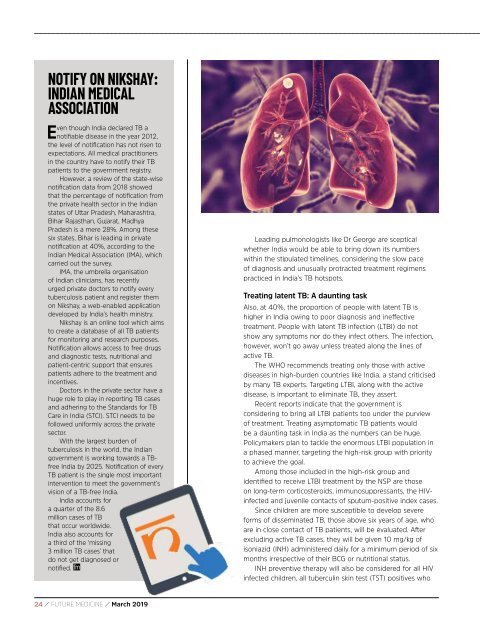March 2019 digital v1
Create successful ePaper yourself
Turn your PDF publications into a flip-book with our unique Google optimized e-Paper software.
NOTIFY ON NIKSHAY:<br />
INDIAN MEDICAL<br />
ASSOCIATION<br />
E<br />
ven though India declared TB a<br />
notifiable disease in the year 2012,<br />
the level of notification has not risen to<br />
expectations. All medical practitioners<br />
in the country have to notify their TB<br />
patients to the government registry.<br />
However, a review of the state-wise<br />
notification data from 2018 showed<br />
that the percentage of notification from<br />
the private health sector in the Indian<br />
states of Uttar Pradesh, Maharashtra,<br />
Bihar Rajasthan, Gujarat, Madhya<br />
Pradesh is a mere 28%. Among these<br />
six states, Bihar is leading in private<br />
notification at 40%, according to the<br />
Indian Medical Association (IMA), which<br />
carried out the survey.<br />
IMA, the umbrella organisation<br />
of Indian clinicians, has recently<br />
urged private doctors to notify every<br />
tuberculosis patient and register them<br />
on Nikshay, a web-enabled application<br />
developed by India’s health ministry.<br />
Nikshay is an online tool which aims<br />
to create a database of all TB patients<br />
for monitoring and research purposes.<br />
Notification allows access to free drugs<br />
and diagnostic tests, nutritional and<br />
patient-centric support that ensures<br />
patients adhere to the treatment and<br />
incentives.<br />
Doctors in the private sector have a<br />
huge role to play in reporting TB cases<br />
and adhering to the Standards for TB<br />
Care in India (STCI). STCI needs to be<br />
followed uniformly across the private<br />
sector.<br />
With the largest burden of<br />
tuberculosis in the world, the Indian<br />
government is working towards a TBfree<br />
India by 2025. Notification of every<br />
TB patient is the single most important<br />
intervention to meet the government’s<br />
vision of a TB-free India.<br />
India accounts for<br />
a quarter of the 8.6<br />
million cases of TB<br />
that occur worldwide.<br />
India also accounts for<br />
a third of the ‘missing<br />
3 million TB cases’ that<br />
do not get diagnosed or<br />
notified.<br />
Leading pulmonologists like Dr George are sceptical<br />
whether India would be able to bring down its numbers<br />
within the stipulated timelines, considering the slow pace<br />
of diagnosis and unusually protracted treatment regimens<br />
practiced in India’s TB hotspots.<br />
Treating latent TB: A daunting task<br />
Also, at 40%, the proportion of people with latent TB is<br />
higher in India owing to poor diagnosis and ineffective<br />
treatment. People with latent TB infection (LTBI) do not<br />
show any symptoms nor do they infect others. The infection,<br />
however, won’t go away unless treated along the lines of<br />
active TB.<br />
The WHO recommends treating only those with active<br />
diseases in high-burden countries like India, a stand criticised<br />
by many TB experts. Targeting LTBI, along with the active<br />
disease, is important to eliminate TB, they assert.<br />
Recent reports indicate that the government is<br />
considering to bring all LTBI patients too under the purview<br />
of treatment. Treating asymptomatic TB patients would<br />
be a daunting task in India as the numbers can be huge.<br />
Policymakers plan to tackle the enormous LTBI population in<br />
a phased manner, targeting the high-risk group with priority<br />
to achieve the goal.<br />
Among those included in the high-risk group and<br />
identified to receive LTBI treatment by the NSP are those<br />
on long-term corticosteroids, immunosuppressants, the HIVinfected<br />
and juvenile contacts of sputum-positive index cases.<br />
Since children are more susceptible to develop severe<br />
forms of disseminated TB, those above six years of age, who<br />
are in close contact of TB patients, will be evaluated. After<br />
excluding active TB cases, they will be given 10 mg/kg of<br />
isoniazid (INH) administered daily for a minimum period of six<br />
months irrespective of their BCG or nutritional status.<br />
INH preventive therapy will also be considered for all HIV<br />
infected children, all tuberculin skin test (TST) positives who<br />
24 / FUTURE MEDICINE / <strong>March</strong> <strong>2019</strong>


















